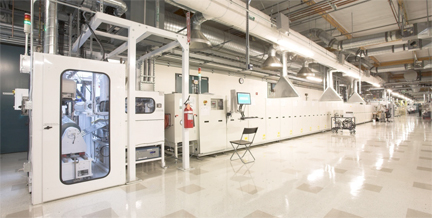Wednesday, September 9th, 2009
After more than 5 years and US$500 million dollars invested, Nanosolar has emerged from secrecy to quell rumors that the company’s technology was all smoke and nanomirrors. This long-shot technology risk is now claimed to produce mean cell efficiencies of 11%, with a champion cell from a Gen3 line measured by NREL at 16%. The use of dual-laminate aluminum foil with metal-wrap through (MWT) back-contacts reduces costs while allowing for improved electrical output. The company claims >US$4B in order backlogs, though the first MW-scale installation is only now in the works.
The world has long known that Nanosolar has been trying to achieve medium efficiency (10-15%) PV technology with an order of magnitude reduction in fab costs compared to thin-film PV leader First Solar’s CdTe on glass single-substrate approach. Using aluminum foil in roll-to-roll (R2R) continuous processing allows for printing-press-like costs, and the substrate itself can be the bottom electrical contact. In contrast, Ascent Solar uses a flexible plastic substrate for R2R CIGS fabrication.
 The nano-ink formulation, the ink printing, and the rapid-thermal processing (RTP) technology (see figure) needed to form 10-15% efficient CIGS cells is the crown jewel in Nanosolar’s IP crown. Other companies may use R2R and printing presses and clever cell contacts, but no other company has invested in CIGS nanoparticle ink technology like Nanosolar to create an inexpensively printed yet high-quality semiconductor.
The nano-ink formulation, the ink printing, and the rapid-thermal processing (RTP) technology (see figure) needed to form 10-15% efficient CIGS cells is the crown jewel in Nanosolar’s IP crown. Other companies may use R2R and printing presses and clever cell contacts, but no other company has invested in CIGS nanoparticle ink technology like Nanosolar to create an inexpensively printed yet high-quality semiconductor.
Prior to working internally to develop the nanoink in 2003 and 2004, Nanosolar investigated a broad range of avenues for printed CIGS. This included chemistries and processes based on partial-oxide spray pyrolysis (for which the company licensed patents US 6,268,014 and US 6,821,559); metal oxides (discarded due to long oxide reduction required and difficulty of including Gallium); organometallic precursors (discarded due to high cost); solid-solution nanoparticles (for which the company licensed US 7,091,136 and US 7,521,344); metal hydroxides and metal salts (US 2008/0280030); hydrazines (discarded due to lack of manufacturability, with many coat/anneals required and hydrogen selenide generated); and high throughput 3D-ALD (US 7,115,304).
 The MWT back-contacts look like they borrow IC packaging substrate technology ideas. Vias are drilled (not specified, but are likely to be cut by lasers) through the CIGS and associated thin-film layers using a single tool capable of supporting hundreds of MW of annual capacity. The cell foil is laminated with a secondary low-cost aluminum foil with an insulating adhesive in between. Insulated holes are filled with a conductive paste to create a conductive via (see figure). MWT cell architecture provides for cells capable of generating and carrying currents of 6-25 Amps, which is claimed to be 3-10x more than is cost efficient with other thin-film PV technologies.
The MWT back-contacts look like they borrow IC packaging substrate technology ideas. Vias are drilled (not specified, but are likely to be cut by lasers) through the CIGS and associated thin-film layers using a single tool capable of supporting hundreds of MW of annual capacity. The cell foil is laminated with a secondary low-cost aluminum foil with an insulating adhesive in between. Insulated holes are filled with a conductive paste to create a conductive via (see figure). MWT cell architecture provides for cells capable of generating and carrying currents of 6-25 Amps, which is claimed to be 3-10x more than is cost efficient with other thin-film PV technologies.
 Nanosolar must be commended for showing the most sensitive of all fab data: process stability over time. The company’s white paper includes the efficiency numbers tested for 150 cells from a single roll (see figure) processed on August 29 of this year at the fab in San Jose. While there are clearly five cells with <4% efficiency, and another five in the 4-8% range, the MWT Gen2 process seems to be under control with average efficiency of 11.75%.
Nanosolar must be commended for showing the most sensitive of all fab data: process stability over time. The company’s white paper includes the efficiency numbers tested for 150 cells from a single roll (see figure) processed on August 29 of this year at the fab in San Jose. While there are clearly five cells with <4% efficiency, and another five in the 4-8% range, the MWT Gen2 process seems to be under control with average efficiency of 11.75%.
The company claims to have developed five incremental generations of R2R processing tool designs between 2005 and 2008. Along with faster rolling speeds, the roll width has been increased from 100mm to 750mm, and 1500mm width processing has been demonstrated. Most of the process steps are non-vacuum, and thus inherently relatively easy to scale up. One of the current largest roles is equivalent to 100kW of PV power, which would be the equivalent of 1,000 glass plates.
Panels are assembled at Nanosolar’s fully-automated line in Germany, where one panel can be produced every 10 seconds. Full 24/7 capacity is claimed to be 640 MW/year of panels. The company claims to have over US$4B in order backlog; though all activity is dependent upon commercial banks for financing. –E.K.
